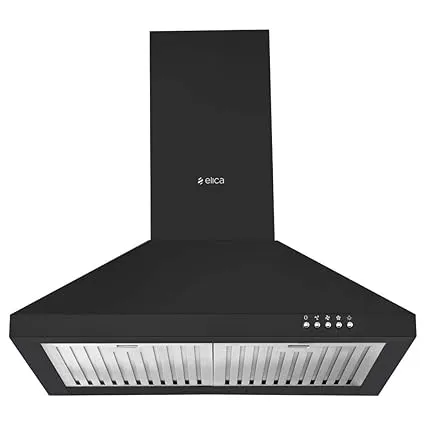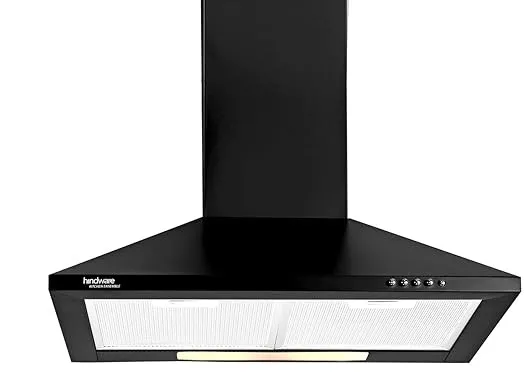Welcome to our comprehensive guide on the Kitchen Chimney Vs Exhaust Fan for Indian Homes | Which Is Better Between Kitchen Chimney and Exhaust Fan?
Kitchen Chimney Vs Exhaust Fan for Indian Homes | Which Is Better Between Kitchen Chimney and Exhaust Fan?

How important is chimney for an Indian kitchen?
A few days ago I got a call from a modern home owner asking, “Is having a chimney more important than having an exhaust fan???
I said…
In today’s world where air pollution matters a lot, exhaust fan is not enough. My suggestion to all home owners is to use a chimney because the exhaust fan only expels smoke from the kitchen and does not expel other impurities like carbon and food particles, oiliness, heavy complex gases, etc. which a chimney does.
Unlike an exhaust fan, the chimney can be installed anywhere in the kitchen. The chimney is mounted above the 26”-30” cooktop. “Kitchen Chimney Vs Exhaust Fan, Kitchen Chimney and Exhaust Fan”
In the modern world, in every home with modular kitchen, cabinets are made for storage. These cabinets are made on the bottom, top, walls, etc. of the platform. In Indian kitchens where oily and spicy food is commonly prepared, the smoke/heat generated causes oil and other impurities to settle on the cabinets above the cooktop.
The fumes and other heavy gases produced while cooking will cause these cabinets to turn yellow very quickly. “Kitchen Chimney Vs Exhaust Fan, Kitchen Chimney and Exhaust Fan”
If there are no cabinets above the platform, oil and other impurities will settle on the main ceiling or false ceiling. Thus, wherever an exhaust fan is installed, the ceiling or cabinets in those houses get damaged soon. Kitchen Chimney Vs Exhaust Fan, Kitchen Chimney and Exhaust Fan
But if a chimney is installed in the kitchen, smoke, dirt and food particles are pulled out through the fan or filter of the chimney. By installing a chimney, the ceiling above the cooking area is protected and the smoke from spreading to other rooms.
Installing a chimney also reduces the cleaning work. The chimney can be cleaned every 10-12 days. Whereas in a kitchen with exhaust fan, cabinets and other furniture have to be cleaned daily, so that they do not get yellowed. did you see what kind of chimney
How it helps in keeping your kitchen and kitchen furniture more clean. “Kitchen Chimney Vs Exhaust Fan, Kitchen Chimney and Exhaust Fan”
If you have both chimney air exhaust fans, be careful not to use the exhaust fan during cooking.
Bathroom Vent Fans India
Some homeowners are lucky enough to have a large window directly opposite the cooking area. Such kitchen design houses can save money by not installing a chimney. In fact, they do not need a chimney at all.
But for those who do not have a window right in front of the cooking area, chimney is the best option to maintain the kitchen environment.
Which Is Better Between Kitchen Chimney and Exhaust Fan? Main Deffrances

Both kitchen chimneys and exhaust fans serve the purpose of ventilating the kitchen and removing smoke, odors, and heat generated during cooking. However, they operate in different ways and offer varying benefits. Here’s a comparison between kitchen chimneys and exhaust fans, particularly in the context of Indian homes:
Kitchen Chimney:
Functionality:
Smoke and Odor Removal: Kitchen chimneys are effective in removing smoke, cooking odors, and grease particles from the air.
Oil and Grease Filtration: Chimneys come with filters (baffle, cassette, or mesh) that trap oil and grease, preventing them from settling on kitchen surfaces.
Better Air Circulation: Chimneys ensure better air circulation, maintaining a cleaner and healthier kitchen environment. “Kicthen Chimney vs Exhaust Fan”
Advantages:
Aesthetic Appeal: Chimneys are available in various designs, adding a modern and aesthetic touch to the kitchen.
Low Maintenance: While filters need periodic cleaning, chimneys generally require less maintenance compared to exhaust fans.
Better Lighting: Many chimneys come with built-in lighting that improves visibility while cooking.
Types:
Ducted Chimneys: Connected to an external outlet, they expel air outside.
Ductless Chimneys: Recirculate filtered air back into the kitchen after trapping contaminants.
Exhaust Fan:
Functionality:
Air Circulation: Exhaust fans primarily circulate air, helping to reduce heat and humidity in the kitchen.
Basic Smoke Removal: While they can remove some smoke, exhaust fans are not as effective as chimneys in trapping grease particles. “Kicthen Chimney vs Exhaust Fan”
Advantages:
Affordability: Exhaust fans are generally more affordable than kitchen chimneys.
Simple Installation: They are easy to install and can be retrofitted into existing kitchen setups.
Disadvantages:
Limited Features: Exhaust fans lack the advanced features of chimneys, such as grease filtration and better smoke removal.
Regular Maintenance: Exhaust fans may require more frequent cleaning, as grease can accumulate on surfaces over time.
Considerations for Indian Homes:
Cooking Style:
Heavy Frying: If you engage in a lot of deep-frying or heavy cooking, a chimney with effective grease filtration is recommended. “Kicthen Chimney vs Exhaust Fan”
Kitchen Size:
Large Kitchens: Chimneys are more suitable for larger kitchens where better air circulation is essential.
Budget:
Limited Budget: If cost is a major consideration, an exhaust fan might be a more economical choice.
Installation:
Existing Setup: If you have constraints in modifying the kitchen layout, an exhaust fan might be easier to install. “Kicthen Chimney vs Exhaust Fan”
How kitchen chimneys and exhaust fans?

How Kitchen Chimneys Work:
Suction Mechanism:
Kitchen chimneys use a suction mechanism to pull in air from the cooking area. This is typically achieved through a powerful motor installed within the chimney.
Filtering Process:
The sucked-in air passes through various types of filters such as baffle filters, cassette filters, or mesh filters. These filters are designed to trap grease, oil particles, and other impurities present in the cooking fumes.
Grease Collection:
As the air moves through the filters, grease and oil particles adhere to the filter surfaces. This prevents the accumulation of grease on kitchen surfaces and maintains a cleaner cooking environment. Kitchen Chimney Vs Exhaust Fan, Kitchen Chimney and Exhaust Fan
Air Disposal:
In ducted chimneys, the purified air is then expelled outside the kitchen through a duct. In ductless chimneys, the air goes through additional purification (using charcoal filters) and is recirculated back into the kitchen. “Kicthen Chimney vs Exhaust Fan”
Additional Features:
Many kitchen chimneys come with additional features such as built-in lighting for better visibility during cooking, touch controls for easy operation, and auto-cleaning functions for reduced maintenance.
How Exhaust Fans Work:
Air Circulation:
Exhaust fans operate by circulating air within the kitchen. They don’t have the sophisticated filtering mechanisms of chimneys but serve to move air, helping to reduce heat and humidity. “Kicthen Chimney vs Exhaust Fan”
Basic Smoke Removal:
While not as effective as chimneys, exhaust fans can help remove basic smoke generated during cooking. However, they are not designed to filter out grease particles or eliminate cooking odors as effectively as chimneys.
Installation:
Exhaust fans are usually mounted on walls or windows. They consist of a fan blade and a motor. When turned on, the fan blade rotates, creating airflow and drawing air out of the kitchen.
Affordability:
Exhaust fans are generally more affordable than kitchen chimneys. They are a simpler solution for basic ventilation needs.
Maintenance:
Regular cleaning is necessary for exhaust fans, as they can accumulate grease and dust on the fan blades and surrounding surfaces over time. “Kitchen Chimney Vs Exhaust Fan, Kitchen Chimney and Exhaust Fan”
In summary, kitchen chimneys use a suction and filtration system to remove cooking fumes, grease, and odors, while exhaust fans primarily circulate air to reduce heat and humidity. Chimneys offer more advanced features and efficient filtration, making them suitable for kitchens with heavy cooking.
On the other hand, exhaust fans are a simpler and more economical option for basic ventilation needs.
Conclusion
In conclusion, both kitchen chimneys and exhaust fans have their advantages and are suitable for different kitchen setups. Consider your cooking habits, kitchen size, budget, and aesthetic preferences before making a choice. For a more effective solution, some homeowners even opt for a combination of both—a chimney for heavy-duty tasks and an exhaust fan for additional ventilation.
FAQs: Kitchen Chimneys and Exhaust Fans
A kitchen chimney is designed to remove smoke, odors, and grease generated during cooking. It helps maintain a cleaner and healthier kitchen environment.
Chimneys work by extracting air through filters that trap grease and pollutants. The purified air is then either expelled outside (ducted chimneys) or recirculated into the kitchen after filtration (ductless chimneys).
Common filters include baffle filters, cassette filters, and mesh filters. They are designed to trap grease particles and prevent them from settling on kitchen surfaces.
Chimneys generally require less maintenance. Regular cleaning of filters is recommended, but they are designed for easy removal and cleaning.
Kitchen chimneys offer better smoke and odor removal, effective grease filtration, aesthetic appeal, and improved air circulation compared to exhaust fans.
Exhaust fans are generally easier to install and can be retrofitted into existing setups. Chimneys may require more intricate installation, especially ducted ones.
Yes, many kitchen chimneys come with built-in lighting to improve visibility during cooking. Some models also offer advanced features such as touch controls and auto-cleaning functions.
While exhaust fans can help with basic smoke removal, they are not as effective as kitchen chimneys in trapping grease particles and eliminating cooking odors.
Exhaust fans are generally more budget-friendly than kitchen chimneys. However, the choice may depend on individual preferences, cooking habits, and the desired features.
These FAQs provide a general overview of kitchen chimneys and exhaust fans, helping you make an informed decision based on your specific needs and preferences.
Thanks for your visit to TrustWelly.com
Please also check our YouTube Channel – Trust Welly – YouTube

